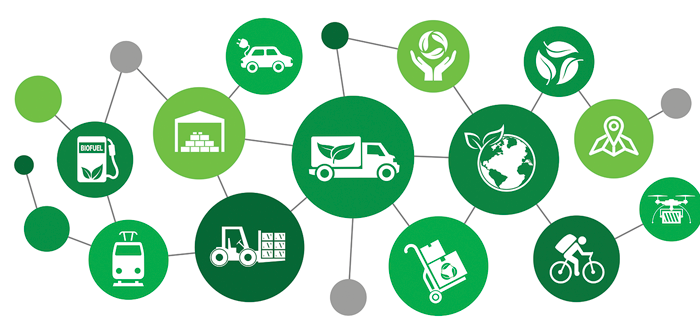Sustainability is now no longer a future initiative. The future is NOW. The UN Sustainable Development Goals (SDG) identifies 17 specific goals to be achieved by 2030. These Sustainable Development Goals are marked 1 through 17 with over 169 targets to be achieved by 2030. Government agencies and corporations are racing to meet these goals and will be asked to report on their own sustainable development goals and actions to protect a more fragile planet.
Sustainability has a predisposition to mean reducing Green House Gas (GHG) or Climate Change. But its definition is much broader. Sustainability Goals and targets have three broad categories:
Sustainability does not presuppose investing in expensive choices for our business operations. Studies have shown that the Environmental Protection Agency’s work on mileage improvements has had a significant improvement in MPG1 resulting in overall reduction of CO2 by over 25% between 2004 and 2021 while fuel economy improvement has been near 32%. Carrier fleets with newer vehicles report healthier margins due to higher reliability and efficiency.
The impact of transportation on sustainability has been recognized as far back as the 1992 UN Earth Summit and has been emphasized in the 2012 and 2020 world conferences. The UN Secretary-General, as part of his Five-Year Action Agenda, has identified transport as a major component of sustainable development

The importance of transport for climate action is further recognized under the UNFCCC – the transport sector will be playing a particularly important role in the achievement of the Paris Agreement, given the fact close to a quarter of energy-related global greenhouse gas emissions come from transport and that these emissions are projected to grow substantially in the years to come.
Sustainability Investments can Improve your Bottom Line
Investments in Sustainable Supply Chain and Transportation can have a positive impact on operational margins and bring in real world benefits to your organization. As the world gets precariously closer to environmental crisis, addressing SDG-11 goal for Sustainable Transportation can have a significant direct and indirect impact in averting the impending crisis.
As a supply chain manager or a transportation czar, a recommended 5 point strategic plan towards greater business efficiency, profit margin and sustainability goals would look something like this.
Benefits from Sustainability Goals for Transportation
| Goal | Sustainability Goal | Benefits |
|---|---|---|
| Reduction in Mileage | Reduce CO2 | 15%-33% Cost benefit |
| Improve Pool Point Operations | Reduce CO2 | 10%-15% Cost |
| Reduce Paperwork | Protecting our Forest (SDG-15, SDG-13) | Improve Cash Flow |
| Reduce Shrinkage | Sustainable Consumption and Production (SDG-12) | 3%-5% COGS |
| Network Visibility | Partnership for Sustainable Development (SDG-17) technology | Useful insights and force multiplier for all of the above |
Goal 1: Reduction in Mileage
Better optimization tools can reduce miles and improve asset utilization. An optimized transportation solution can improve operational efficiency by nearly 30% resulting in lower fuel cost, and higher driver and vehicle utilization. Enterprises can improve on executing time constrained deliveries through accurate predictive ETAs that reduce chances of re-deliveries and missed appointments.
Goal 2: Improving Pool Point Operations
Transportation planning tools can evaluate poolpoint efficiencies and recommend the right locations and capacities to achieve higher utilization, reduce miles and lower costs. Shippers and carriers can improve their cost effectiveness by 10%-15% through use of these solutions by positioning their most efficient resources into the appropriate geographical locations.
Goal 3: Reduce Paperwork
Paper manifests, bills of lading and POD documents can occupy large storage space for several years. Electronic documents and ePODs can save entire forests each year from decimation. At nuVizz we have helped enterprises reduce 15-20 M sheets of paper, saving more than 200 acres of forest trees each year. Beyond saving the cost of paper, printers and the ink, digitization reduces DSO (Days Sales Outstanding) by almost 2 weeks improving cash flow, reducing billing department overheads and enhancing customer satisfaction.
Goal 4: Reduce Merchandise Loss (Shinkage)
Every year shippers experience a loss in value of 3%-10% due to shrinkage and loss of goods. Supply chain and transportation departments track this through the OS&D (Overage, Shortage & Damage) metrics. Shrinkage impacts sustainability in two different ways – 1) every item lost requires producing additional quantities to meet the unfulfilled customer requirement 2) short items require additional runs to redeliver them. Using scanning solutions, enterprises can minimize shrinkage and gain valuable insight into where and when these losses happen within the delivery process. These insights can help further fool proof the delivery process and eliminate shrinkage.
Goal 5: Network Visibility – Resiliency towards Supply Chain Disruptions
A recent Gartner survey found that 76% of supply chain executives say their company is facing more frequent disruptions than three years ago. As climate change invariably leads to larger environmental disruptions in the form of storms, floods, harsh winters and summers; transportation must improve resiliency. A multi-tier shipping operation with a heterogeneous carrier network complicates this challenge further. Most organizations find themselves in situations where the time to address a problem takes longer than the duration of the problem. Covid-19 exposed this problem in our supply chains quite dramatically. Such large scale disruptions cannot be ruled out in future. Building resilience in our supply chains will be the key to facing these uncertain events. Network visibility is key to building resilience. It enables enterprises to collect information in real time and provide actionable insights to make changes in real time.
Conclusion
Transport contributes directly to five SDG targets on road safety (Target 3.6); energy efficiency (Target 7.3); sustainable infrastructure (Target 9.1), urban access (Target 11.2), and fossil fuel subsidies (Target 12.c) emphasize that sustainable transport is needed not only for its own sake, but also to facilitate the achievement of a wide variety of SDGs. Transport also contributes indirectly to seven SDG targets on agricultural productivity (Target 2.3), air pollution (Target 3.9), access to safe drinking water (Target 6.1), sustainable cities (Target 11.6), reduction of food loss (Target 12.3), climate change adaptation (Target 13.1), and climate change mitigation (Target 13.2)
Regardless of where you are in your journey towards sustainability, there are many endearing benefits that come with it. It is only a matter of time when shippers and your customers will begin to ask the probing questions about your sustainable journey. Customers will invariably choose partners whose practices align with their sustainability goals. You cannot be left behind on this path breaking journey. A holistic delivery management platform like nuVizz can make this journey smooth and rewarding. Contact us today!!!
References
- Automotive MPG trends published by EPA
https://www.epa.gov/automotive-trends/highlights-automotive-trends-report#:~:text=All%20five%20vehicle%20types%20are,pickups%20increased%20by%200.1%20mpg. - Sustainable Transportation – SDGS
https://sdgs.un.org/topics/sustainable-transport

